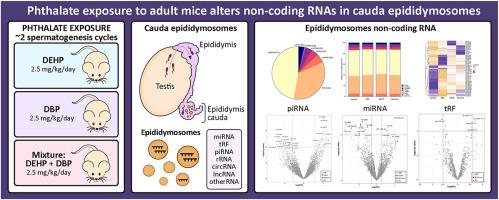邻苯二甲酸盐暴露于成年小鼠可改变尾状附睾小体中的非编码rna
IF 7.3
2区 环境科学与生态学
Q1 ENVIRONMENTAL SCIENCES
引用次数: 0
摘要
我们之前报道了抗雄激素邻苯二甲酸酯的尿液生物标志物与接受生育治疗的男性精浆中细胞外囊泡(EVs)的小非编码RNA (sncRNA)组成之间的关联。为了补充这些发现,我们评估了暴露于抗雄激素邻苯二甲酸酯、邻苯二甲酸二丁酯(DBP)、邻苯二甲酸二(2-乙基己基)酯(DEHP)及其混合物后小鼠尾附睾运动体的sncrna。雄性小鼠暴露于2.5 mg/kg/天DBP或DEHP及其混合物(DBP和DEHP各2.5 mg/kg/天)6周。分离附睾尾染色体RNA并进行测序以评估其非编码RNA (ncRNA)含量。使用STAR比对工具和EdgeR (Fold change, FC≥1.5和p <; 0.01)分别使用暴露组与对照组之间的计数进行reads到转录组的映射和标准化reads计数的差异表达。附睾染色体ncRNAs的图谱读数主要是piRNAs(47%),其次是tRFs(34%)和miRNAs(6%)。邻苯二甲酸盐暴露共改变了79种(DBP = 47; DEHP = 11;混合物= 21)附睾染色体sncRNA生物型(miRNA = 14, trf = 5; piRNA = 60)。据预测,这些ncrna靶向参与各种功能过程的基因,包括组织发育、嗅觉感知和钾通道活性。据我们所知,这是第一个表明成年雄性小鼠暴露于邻苯二甲酸盐会破坏附睾尾体ncRNA谱的研究。这些数据表明附睾尾体ncrna对环境暴露有反应,可能对下一代的健康和发育有影响。本文章由计算机程序翻译,如有差异,请以英文原文为准。

Phthalate exposure to adult mice alters non-coding RNAs in cauda epididymosomes
We have previously reported associations between urinary biomarkers of anti-androgenic phthalates and small non-coding RNA (sncRNA) compositions of extracellular vesicles (EVs) in seminal plasma of men undergoing fertility treatment. To complement these findings, we assessed sncRNAs of cauda epididymosomes in mice after exposure to the anti-androgenic phthalates, Di-n-butyl phthalate (DBP), Di(2-ethylhexyl) phthalate (DEHP), and their mixture.Male mice were exposed to 2.5 mg/kg/day of DBP or DEHP and their mixture (2.5 mg/kg/day each of DBP and DEHP) for six weeks. Cauda epididymosomal RNA were isolated and subjected to sequencing to assess their non-coding RNA (ncRNA) content. Mapping of reads to transcriptomes and differential expression of normalized read counts were conducted using counts between the exposed groups relative to controls using STAR alignment tool and EdgeR (Fold change, FC ≥ 1.5 and p < 0.01), respectively.The mapped reads of epididymosomal ncRNAs were mostly piRNAs (47%), followed by tRFs (34%) and miRNAs (6%). Phthalate exposures altered a total of 79 (DBP = 47; DEHP = 11; mixture = 21) epididymosomal sncRNA biotypes (miRNA = 14, tRFs = 5 & piRNA = 60). These ncRNAs were predicted to target genes involved in various functional processes, including tissue development, olfactory perception, and potassium channel activity.This is the first study, to our knowledge, to show that exposure to phthalates in adult male mice disrupts the ncRNA profiles of cauda epididymosomes. These data suggest that cauda epididymosomes ncRNAs are responsive to environmental exposures and may have implication in the health and development of the next generation.
求助全文
通过发布文献求助,成功后即可免费获取论文全文。
去求助
来源期刊

Environmental Pollution
环境科学-环境科学
CiteScore
16.00
自引率
6.70%
发文量
2082
审稿时长
2.9 months
期刊介绍:
Environmental Pollution is an international peer-reviewed journal that publishes high-quality research papers and review articles covering all aspects of environmental pollution and its impacts on ecosystems and human health.
Subject areas include, but are not limited to:
• Sources and occurrences of pollutants that are clearly defined and measured in environmental compartments, food and food-related items, and human bodies;
• Interlinks between contaminant exposure and biological, ecological, and human health effects, including those of climate change;
• Contaminants of emerging concerns (including but not limited to antibiotic resistant microorganisms or genes, microplastics/nanoplastics, electronic wastes, light, and noise) and/or their biological, ecological, or human health effects;
• Laboratory and field studies on the remediation/mitigation of environmental pollution via new techniques and with clear links to biological, ecological, or human health effects;
• Modeling of pollution processes, patterns, or trends that is of clear environmental and/or human health interest;
• New techniques that measure and examine environmental occurrences, transport, behavior, and effects of pollutants within the environment or the laboratory, provided that they can be clearly used to address problems within regional or global environmental compartments.
 求助内容:
求助内容: 应助结果提醒方式:
应助结果提醒方式:


